Page 1 of 2
Crabs Are Shedding (Pics)
Posted: Wed Nov 28, 2007 9:05 pm
by PhilK
So I must be doing something right, because when I woke up today there was an empty crab shell and a brand new crab sitting next to it looking very proud indeed. I went to watch TV and came back 3 hours later and there was
another one that had shed! This was a much fresher shed and the crab has a weird purpley/maroon colour to it. Amazing that they shed and harden up in the water.
Here are some photos.
This is the shed from the first crab. Second shed I broke while picking up. Can anybody sex this crab?
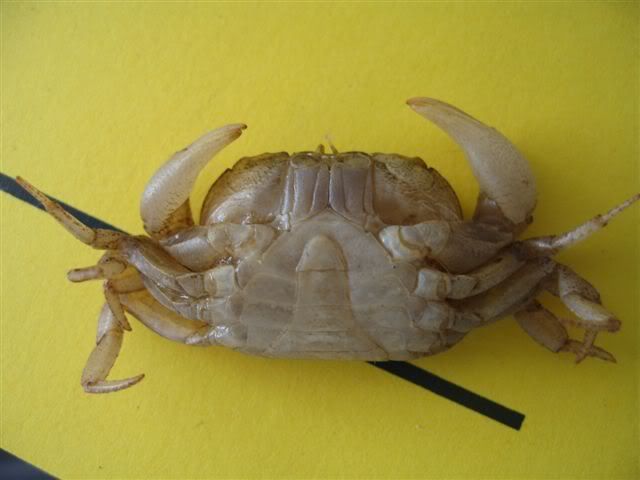
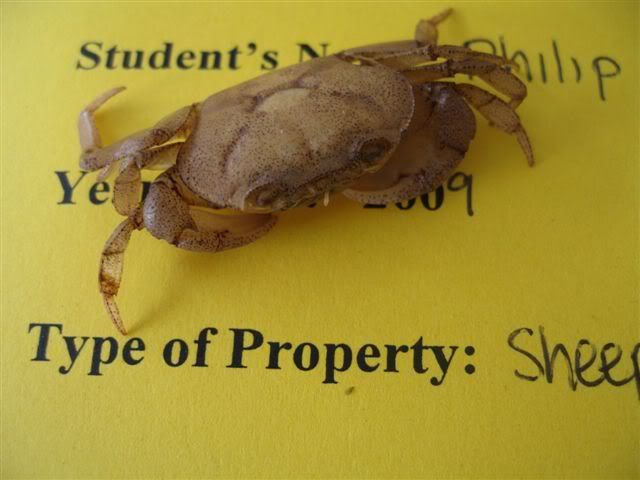
This crab is the proud owner of the above shed
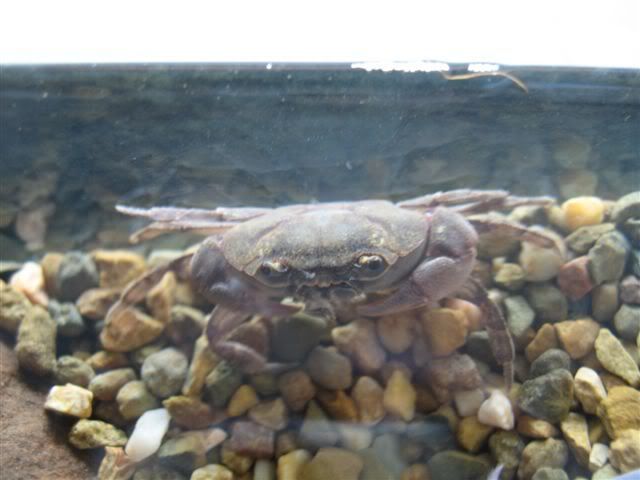
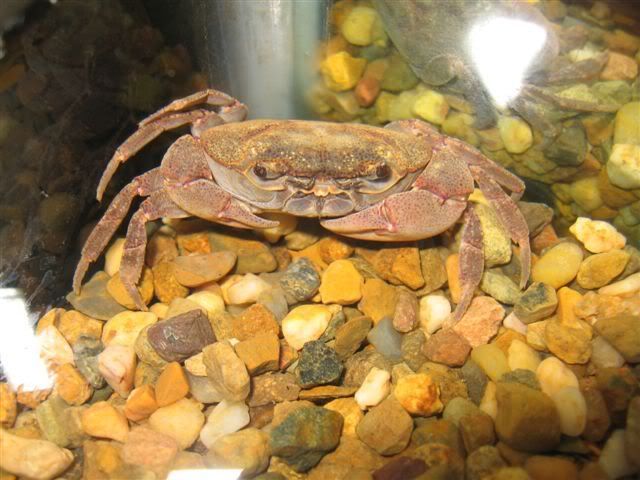
This crab is the one that shed more recently. Note the odd colour. He also had the added job of regenerating three legs on one side.
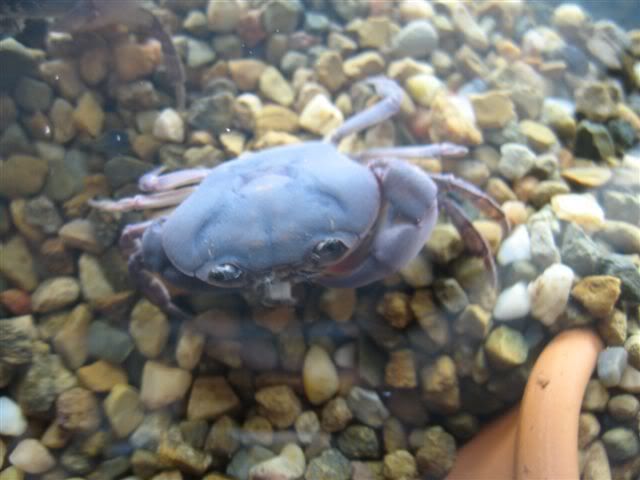
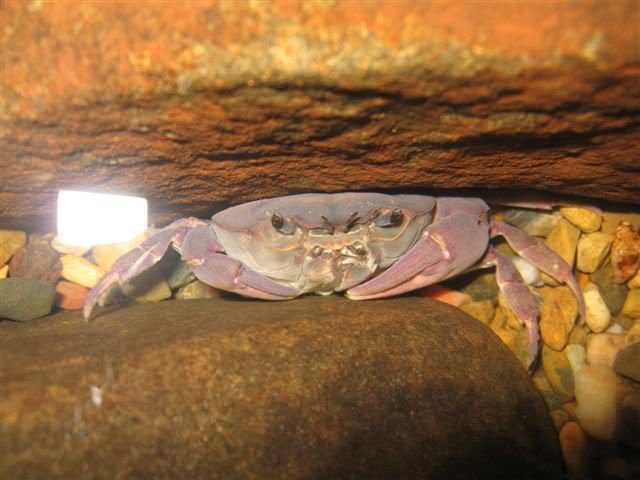
Some comparison pics between the two
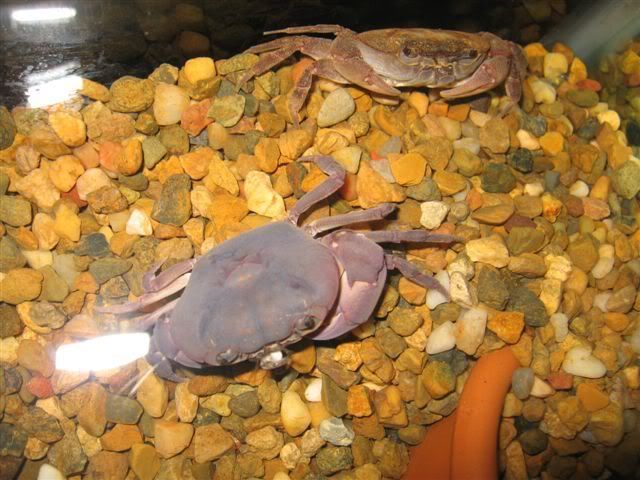
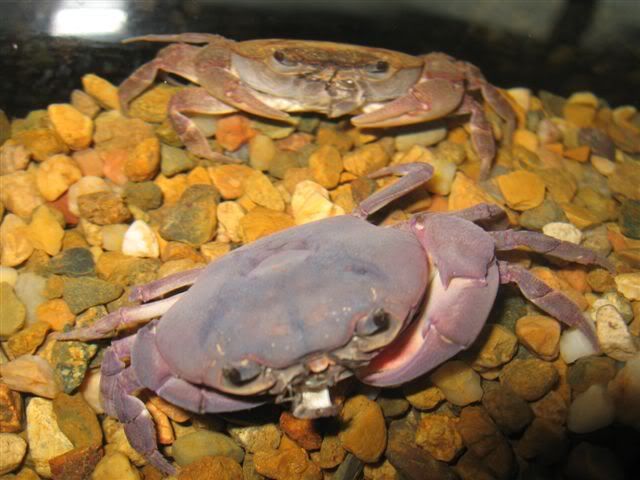
Two of the others that were out and about at the time of photos. One is sitting on one of my snails, Clem.
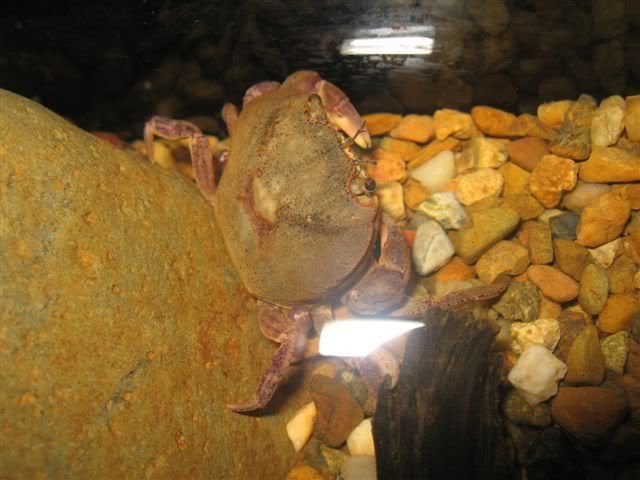
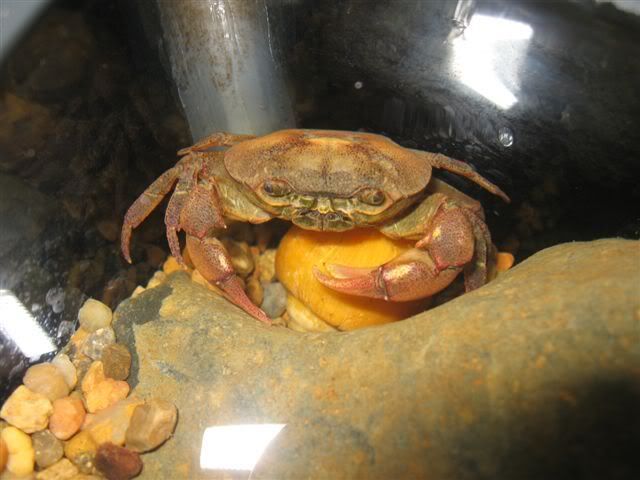
The other member of the cleanup crew, Sheldon. Can anybody ID these snails?

All crabs are named Zoidberg, except the purpleish one that my mates girlfriend named Eugene.

Posted: Wed Nov 28, 2007 11:40 pm
by Mustafa
The crab is a male. The snail should be Pomacae diffusa. Thanks for sharing.

Posted: Thu Nov 29, 2007 1:37 am
by Neonshrimp
Nice pictures of your animals, thanks

Posted: Thu Nov 29, 2007 6:08 am
by badflash
Mustafa-
What makes you say that this is Pomacea bridgesii diffusa as opposed to just the plain Pomacea bridgesii?
PhilK-
Can you get a shot of the spire at an angle? I'd like to see how the wholrls meet.
Posted: Thu Nov 29, 2007 8:28 am
by Mustafa
badflash wrote:Mustafa-
What makes you say that this is Pomacea bridgesii diffusa as opposed to just the plain Pomacea bridgesii?
Because *all* the "bridgesii" in the hobby are actually P. diffusa (formerly P. bridgesii diffusa) according to recent genetic analyses. P. diffusa is widely distributed in the Amazon basin, whereas P. bridgesii has a very restricted distribution. Also, P. bridgesii is supposed to get quite a bit bigger than all the color varieties of P. diffusa that you see in the hobby. Another supporting fact for my claim is that the snails that got established in Florida and that were thought to be P. bridgessi, turned out to be P. diffusa after genetic analysis. These snails "escaped" from the hobby and thus are from the same stock. It is highly unlikely that the very restricted P. bridgesii was ever imported, and, even if it did get imported, that it ever spread in the hobby.
Now watch the "snail experts" go crazy about this piece of information, too....

(as they did over my claim/fact that malaysian trumpet snails can live/breed in saltwater).
Anyway, here is a scientific paper that sheds some light and provides the titles of other papers that can shed even more light:
http://www.pubmedcentral.nih.gov/articl ... id=1919357
Pay special attention to the section talking about P. diffusa.
PhilK-
Can you get a shot of the spire at an angle? I'd like to see how the wholrls meet.
I wouldn't worry about it. He lives in Australia and Australia allows only P. diffusa ("bridgesii") to be imported into the country. All other apple snails are banned. Given the extremely strict Australian regulations and prompt enforcement, it would be highly unlikely that someone managed to get some P. canaliculata into the country and spread them in stores. It's not an impossibility of course...
However, after these apple snails (P. canaliculata and/or related species) took over southeast Asia, Australia has been keeping en eye on them like a hawk. After all Australia is "just around the corner."
Posted: Thu Nov 29, 2007 9:13 am
by badflash
Cool. I'll pass this on. Always happy to learn something new. Genetic analysis will set a lot of things spinning in a different direction.
Posted: Thu Nov 29, 2007 9:37 am
by badflash
Just out of curiosity, since their samples were from wild caught snails and not from colored apple snails, how does one get a snail genetically analyzed? The diffusa seems to be described as a small snail and the brigs as a larger snail. Some of mine get quite large, nearly as large as a male cana. I'd be glad to offer some up to be checked.
Posted: Thu Nov 29, 2007 12:57 pm
by Mustafa
Well, the P. diffusa they caught in Florida aren't technically "wild", but feral since they don't occur there naturally. Even if many colored snails were among first snails to colonize Florida, the conspicuously colored ones would have died out over time so that only wild colored ones remain. This is a well known and well-documented process in fish and other animals. The connection to the "colored" snails is that the feral snails are originally from the hobby. Logic dictates that *usually* the most common species gets established, not the rare, restricted species that possibly has never been imported in large numbers (or ever?). So, until there is evidence to the contrary, it's prudent to assume that the P. bridgesii in the hobby are all P. diffusa.
As for size...I can tell you from my own experiences with wild snails, that most of them tend to be much smaller than what they would be in captivity since food is a limiting factor in nature. So, when they say that the P. diffusa is smaller than P. bridgesii they refer to the "average" animal caught in the wild. Animals in captivity, and especially certain individuals can and do get larger than what's stated in scientific literature.
Also, in my own experience, all the adult (several years old) "brigs" (shouldn't it be "bridgs"??

) that I have seen over the years have been medium sized, nowhere near an even average sized adult P. canaliculata. However, these snails were not pet snails that got fed specifically but just "clean up crew" in fish tanks.
But then...the P. canaliculatas that I am comparing them to were also just clean up crews.
Having said that, there is of course a chance that P. bridgesii did get imported at some point and hybridized with P. diffusa, but until someone goes out of his/her way to undertake a large scale genetic analysis of the snails in the hobby we have only the current scientific papers to go by.
Posted: Thu Nov 29, 2007 2:17 pm
by badflash
How long have you seen colored apple snails in the hobby Mustafa? I'm not nearly as well traveled as you, but until about 3 years ago I'd never seen anything but canas and what were called brigs (yes I know a purest would put the D in there but it is just too hard to say) Of these snails the only colors I'd seen were wild/dark & yellow. Then about 3 years ago I started seeing ivories and blues. Then 2 years ago I saw the first true purples.
Why would we assume that the snails in the hobby came from Florida snails?
What would it take to get a snail genetically checked? Do most universities have that capability?
Posted: Thu Nov 29, 2007 2:39 pm
by Mustafa
badflash wrote:How long have you seen colored apple snails in the hobby Mustafa? I'm not nearly as well traveled as you, but until about 3 years ago I'd never seen anything but canas and what were called brigs (yes I know a purest would put the D in there but it is just too hard to say) Of these snails the only colors I'd seen were wild/dark & yellow. Then about 3 years ago I started seeing ivories and blues. Then 2 years ago I saw the first true purples.
The yellow "brigs" must have been around for ages, because while I was still in Germany there were reports of yellow apple snails that were eating plants (probably canas) and others that woudl leave plants alone (that would be the "brigs"). I don't know about the other colors really, but there is no reason to believe that they are from a completely different stock. These snails have been bred in captivity for a while now, so the other colors are most likely just mutations of the main "captive stock" instead of new collections from the wild or mutation from newly collected wild snails.
By the way...since the "brigs" are most likely P. diffusa, may I suggest the name "diff" as a substitute for brig?


Why would we assume that the snails in the hobby came from Florida snails?
We are not assuming that. The idea is that at some point lots of wild "diffs"

were collected in South America and shipped all over the world. Since they are very easy to breed fish farms and hobbyists all over the world started breeding them. So, a captive population developed. I doubt that any "diffs" have been collected in the wild and imported in many, many years. The Florida snails are from this captive population (Unless, of course, someone went out of his/her way to travel to South America and specifically collected some wild snails to introduce them to Florida.) They are, so to say, representatives of the snails that have been bred in the hobby for a long time now. Just like with shrimp, the snails in the hobby are highly inbred and should form a pretty small genetic pool. The chances that snails in different parts of the country are somehow genetically all that different, or even different species, is extremely small. Hence the Florida snails that escaped and are now living in the wild are genetically still part of the "captive population" that has been in the hobby for a number of years. Get it?

I'm just using simple logical deductions and probabilites given the information to come to a conclusion. Many scenarios and "facts" in science are "most likely" scenarios and facts, especially in cases where one does not have the ability to know for sure what *exactly* happened. It's just a lot more likely (a whole lot more) that we have P. diffusa in the hobby given the current information.
What would it take to get a snail genetically checked? Do most universities have that capability?
Most research universities have that capability, but that's not enough. You need someone that actually specializes in the genetics of the animal you are testing so they can compare it to genetic samples of other animals of the same species stored in gene banks. The whole thing should cost between a few hundred to a few thousand dollars depending on the techniques and methods used.
Posted: Thu Nov 29, 2007 5:28 pm
by badflash
Diffs seem good to me. I'll be sure to credit you with the coinage.

I can't argue with the possibility that the colored snails could be derived from "wild" stock already here, but at the same time new introductions can't be ruled out. The change in imports and the ability to rapidly bring new animals into the country both legally and illegally has sky-rocketed in the last 10 years.
For sure the yellow plant eaters were not brigs or diffs. Interestingly enough, I have yet to produce offspring from crosses with my dark footed purples and my light footed yellows. It isn't for lack of trying. The yellows do mate with other yellows and produce young. As close as Diffs and Brigs seem to be I'd expect them to be able to hybridize.
Do you know of any universities in the NYC area with the capability to check? I could swing a few hundred just to see.
Posted: Thu Nov 29, 2007 6:04 pm
by PhilK
Woah didn't we veer way off course!! Hahahaha. So all I can tell is that they are P. diffusa because that's the only aquarium snail in Australia?
Also, another crab shed this morning. Weird they're all doing it in succession!
Posted: Thu Nov 29, 2007 6:19 pm
by badflash
What is for sure is the snail is an apple snail and appears to be the snail "formerly known as Pomacea bridgesii" . The reason I wanted to see the spire is to see if it might be a Cana. I have a good friend in Australia that keeps canas, so I thought it could be that too. They are easy to tell from brigs (AKA Diffs) by the way the whorl meets. Canas also eat live plants and Bridgs/Diffs don't.
Sorry your thread got hi-jacked, but you DID open the door with your question

Posted: Fri Nov 30, 2007 4:18 am
by PhilK
No worries mate.
Posted: Fri Nov 30, 2007 11:36 am
by fishbone
Are you 100% sure those crabs are freshwater? What species are they?






















